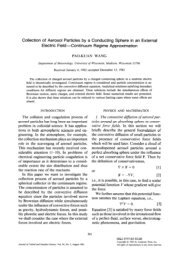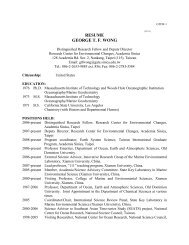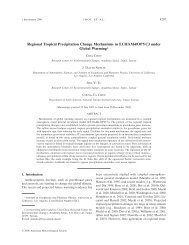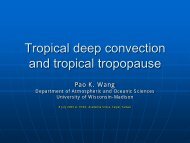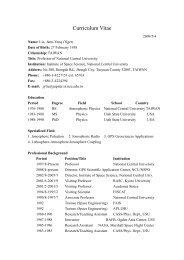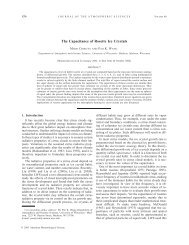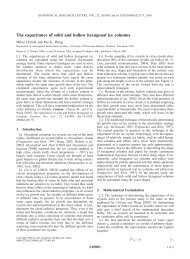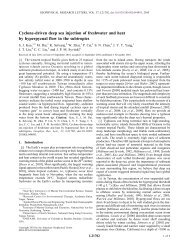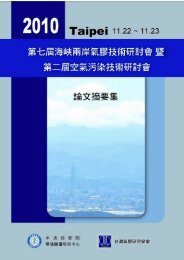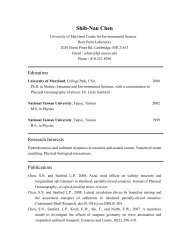Collision Efficiencies of Ice Crystals at LowâIntermediate Reynolds ...
Collision Efficiencies of Ice Crystals at LowâIntermediate Reynolds ...
Collision Efficiencies of Ice Crystals at LowâIntermediate Reynolds ...
You also want an ePaper? Increase the reach of your titles
YUMPU automatically turns print PDFs into web optimized ePapers that Google loves.
1002 JOURNAL OF THE ATMOSPHERIC SCIENCESVOLUME 57inviscid flow fields past disks. Pitter and Pruppacher(1974) and Martin et al. (1981) performed calcul<strong>at</strong>ions<strong>of</strong> the collision efficiency between ice pl<strong>at</strong>es and supercooleddroplets assuming th<strong>at</strong> the flow fields pasthexagonal pl<strong>at</strong>es can be approxim<strong>at</strong>ed by th<strong>at</strong> past thinobl<strong>at</strong>e spheroids. Schlamp et al. (1975) calcul<strong>at</strong>ed theefficiencies with which columnar ice crystals collidewith supercooled droplets assuming th<strong>at</strong> the flow fieldspast an ice column can be approxim<strong>at</strong>ed by th<strong>at</strong> past aninfinitely long cylinder. While these studies contributedsignificantly to our early understanding <strong>of</strong> the onset <strong>of</strong>riming process, there is room for improvement. Furthermore,all <strong>of</strong> these studies assumed th<strong>at</strong> flow fieldsare steady, which is not valid for larger ice crystals th<strong>at</strong>fall in an unsteady <strong>at</strong>titude (Pruppacher and Klett 1997).Recently, Ji and Wang (1989, 1991) and Wang andJi (1997) performed calcul<strong>at</strong>ions <strong>of</strong> the flow fields pastthree different shapes <strong>of</strong> ice crystals: hexagonal icepl<strong>at</strong>es, broad-branch crystals, and ice columns. Theshapes <strong>of</strong> ice crystals used in their calcul<strong>at</strong>ions are morerealistic than those mentioned before. Also, unsteadyfe<strong>at</strong>ures such as eddy shedding were included in thecalcul<strong>at</strong>ions. These improvements ultim<strong>at</strong>ely led tomore accur<strong>at</strong>e comput<strong>at</strong>ion <strong>of</strong> flow fields. The presentstudy is based on the flow fields as determined by Wangand Ji (1997). Using these fields we calcul<strong>at</strong>ed the collisionefficiencies with which ice crystals <strong>of</strong> the abovethree shapes collided with supercooled droplets. Thedetails <strong>of</strong> the formul<strong>at</strong>ions, results, and conclusions arereported below.2. Physics and m<strong>at</strong>hem<strong>at</strong>icsThe theoretical problem <strong>of</strong> determining the collisionefficiency between an ice crystal and a supercooledcloud droplet mainly involves the solution <strong>of</strong> the equ<strong>at</strong>ion<strong>of</strong> motion <strong>of</strong> the droplet in the vicinity <strong>of</strong> the fallingice crystal. Since the motions occur in a viscous medium,air, the effect <strong>of</strong> flow fields must be considered.The flow fields around falling ice crystals are complic<strong>at</strong>edand are normally obtained by solving relevantNavier–Stokes equ<strong>at</strong>ions governing the flow. The inform<strong>at</strong>ion<strong>of</strong> these flow fields is fed into the equ<strong>at</strong>ion<strong>of</strong> motion and the l<strong>at</strong>ter is solved (usually by numericaltechniques) to determine the ‘‘critical trajectory,’’ th<strong>at</strong>is, the trajectory <strong>of</strong> the droplet th<strong>at</strong> makes grazing collisionwith the crystal [see, e.g., chapter 14 <strong>of</strong> Pruppacherand Klett (1997) for an explan<strong>at</strong>ion <strong>of</strong> the grazingtrajectory]. Finally, the collision efficiency is calcul<strong>at</strong>edbased on the knowledge <strong>of</strong> the grazing trajectory. In thefollowing, these steps are described one by one.a. Flow fields around falling ice crystalsAs indic<strong>at</strong>ed above, the first step <strong>of</strong> determining thecollision efficiency is to determine the flow fields aroundfalling ice crystals. This is done by solving the incompressibleNavier–Stokes equ<strong>at</strong>ions for flow past icecrystals:u P2 (u · )u u, (1)twhere u is local flow velocity vector, P the dynamicpressure associ<strong>at</strong>ed with the flow field, air density and the kinem<strong>at</strong>ic viscosity <strong>of</strong> air. In the context <strong>of</strong> numericalcalcul<strong>at</strong>ions, this equ<strong>at</strong>ion is <strong>of</strong>ten nondimensionalizedby utilizing the following nondimensionalvariables:x u tu x , u , t ,a1 u a1P2u aP , Re 12, (2)uwhere x (or y, z) is one <strong>of</strong> three Cartesian coordin<strong>at</strong>es;a 1 the characteristic dimension <strong>of</strong> the ice particle; u the free-stream velocity, which is equal to the terminalfall velocity <strong>of</strong> the ice crystal; and Re is the <strong>Reynolds</strong>number relevant to the flow. All primed quantities arenondimensional. Using these dimensionless variables,we can write the nondimensional Navier–Stokes equ<strong>at</strong>ionand the continuity equ<strong>at</strong>ion as (after dropping theprimes)u 22 u · u P utRe(3) · u 0. (4)The ideal boundary conditions appropri<strong>at</strong>e for thepresent problems areu 0 <strong>at</strong> the surface <strong>of</strong> the ice crystal, and (5)u 1·ez<strong>at</strong> infinity, (6)where e z is a unit vector in the free stream direction.The details <strong>of</strong> the numerical procedure have been givenin a recent paper by Wang and Ji (1997), so they willnot be repe<strong>at</strong>ed here. The velocity vectors so obtainedare input into the equ<strong>at</strong>ion <strong>of</strong> motion to be describedbelow.b. Equ<strong>at</strong>ion <strong>of</strong> motion and droplet trajectoryThe equ<strong>at</strong>ion <strong>of</strong> motion <strong>of</strong> a cloud droplet <strong>of</strong> radiusa 2 in the vicinity <strong>of</strong> a falling ice crystal <strong>of</strong> characteristicdimension a 1 is2dV d rm m Fg F D, (7)dt dt 2where m is the mass <strong>of</strong> the droplet, V its velocity, r itsposition vector, F g the buoyancy-adjusted gravit<strong>at</strong>ionalforce, and F D the hydrodynamic drag force due to theflow. These two forces are expressed as
15 APRIL 2000 WANG AND JI1003w aF mg , (8)gwhere w and a are the density <strong>of</strong> w<strong>at</strong>er and air, respectively,andCDReFD 6a 2(V u). (9)24In order to calcul<strong>at</strong>e the drag force (9), we need to inputthe local flow velocity u <strong>at</strong> each time step. Th<strong>at</strong> valuecomes from the solution <strong>of</strong> (3).In order to solve Eq. (7), it is also necessary to specifyan initial condition. The appropri<strong>at</strong>e initial conditionhere is the initial horizontal <strong>of</strong>fset y <strong>of</strong> the droplet fromthe vertical line passing through the center <strong>of</strong> the fallingice crystal (see Pruppacher and Klett 1997, p. 569).Needless to say, this <strong>of</strong>fset has to be set <strong>at</strong> a distancesufficiently upstream to ensure th<strong>at</strong> the droplet is progressingin a straight line <strong>at</strong> the time. In this study theinitial <strong>of</strong>fset was set <strong>at</strong> 20 radii upstream <strong>of</strong> the icecrystal and it was proven adequ<strong>at</strong>e for the above-st<strong>at</strong>edpurpose. With this initial condition in place, Eq. (7) canbe solved for V and hence r <strong>of</strong> the droplet as a function<strong>of</strong> time. The l<strong>at</strong>ter defines its trajectory.To determine the collision efficiency, we need to determinethe critical initial <strong>of</strong>fset y c <strong>of</strong> the droplet suchth<strong>at</strong> it will make a grazing collision with the ice crystal.An initial <strong>of</strong>fset gre<strong>at</strong>er than y c would result in a miss,whereas one smaller than y c would result in a hit. Inthe present study, a bisection technique, similar to th<strong>at</strong>used in Miller and Wang (1989), was used to determiney c . Once this is done, the next step is determining thecollision efficiency E. wc. <strong>Collision</strong> efficiencySince the collector is an ice crystal th<strong>at</strong> is usually nota sphere, it is important to take a closer examin<strong>at</strong>ion <strong>of</strong>the proper definition <strong>of</strong> collection efficiency here. Theold definition <strong>of</strong> collision efficiency based on sphericalsymmetry [e.g., Pruppacher and Klett 1997, Eq. (14-1)]is inappropri<strong>at</strong>e here. The proper definition <strong>of</strong> E here isthe one given by Wang (1983), namely,K AE , (10)K* A*where K is the collision kernel, K* the geometrical collisionkernel, A the collision cross section, and A* thegeometrical collision cross section (see Fig. 1 for aclearer definition). The rel<strong>at</strong>ion between the collisionkernel and collision cross section isK A(V u). (11)This definition takes care <strong>of</strong> the nonspherical shape <strong>of</strong>the ice crystal and is more general than the usual definition<strong>of</strong> collision efficiency based on the ‘‘radius’’ <strong>of</strong>the collector th<strong>at</strong> is strictly valid for only spheres. ThusFIG. 1. A schem<strong>at</strong>ic explan<strong>at</strong>ion <strong>of</strong> the collision cross section, usinga columnar ice crystal as an example. The hexagon-filled area representsthe collision cross section A, the middle rectangle the crosssection (horizontal projection) <strong>of</strong> the ice column. The outermost rectanglerepresents the geometrical collision cross section A*.cloud droplets loc<strong>at</strong>ed within A (or K) will be eventuallycollected by the ice crystal and turn into rime. Note th<strong>at</strong>the definition <strong>of</strong> collision efficiency as given by (10)assumes th<strong>at</strong> the droplets are <strong>of</strong> the same size. The efficiencywould vary if we deal with a distribution <strong>of</strong>drop sizes, but this is not wh<strong>at</strong> we tre<strong>at</strong> here.In the case <strong>of</strong> unsteady flow fields, the trajectory <strong>of</strong>a droplet starting from a certain initial <strong>of</strong>fset was determinedby averaging a few trajectories over a cycle<strong>of</strong> eddy shedding periods. This was done for a few cases,but it was l<strong>at</strong>er found to be unnecessary because thesetrajectories vary very little as grazing collisions in thisstudy all occur in the upstream regions where flow fieldsare steady. In addition, droplets are massive enough todefy small fluctu<strong>at</strong>ions in the flow fields. This may notbe the case if the collection <strong>of</strong> submicron particles byhydrometeors is considered since rear capture may occurin th<strong>at</strong> case (e.g., Wang et al. 1978; Wang and Jaroszczyk1991) and the unsteady fields in the downstreamwould have gre<strong>at</strong>er effect.3. Results and discussion<strong>Ice</strong> crystal collectors <strong>of</strong> three different habits are consideredin this study: columnar ice crystals (approxim<strong>at</strong>edas finite circular cylinders), hexagonal ice pl<strong>at</strong>es,and broad-branch ice crystals. Tables 1, 2, and 3 showthe dimensions <strong>of</strong> these ice crystals. These are the sameset <strong>of</strong> ice crystals whose flow fields and ventil<strong>at</strong>ion coefficientswere computed by Wang and Ji (1997) Ji andWang (1999), respectively. Figure 2 shows several trajectories<strong>of</strong> a droplet <strong>of</strong> 2-m radius moving around afalling broad-branch crystal <strong>of</strong> Re 10. Of the eighttrajectories shown here, trajectories 1, 2, 6, 7, and 8 aremisses, whereas trajectories 3, 4, and 5 are hits. Trajectory4 is the central trajectory, while 3 and 5 aregrazing trajectories.Note th<strong>at</strong> since the collector ice crystals are notspheres, the critical initial <strong>of</strong>fset y c does not possess
1004 JOURNAL OF THE ATMOSPHERIC SCIENCESVOLUME 57TABLE 1. <strong>Reynolds</strong> numbers, dimensions, and capacitance <strong>of</strong> columnarice crystals in the present study. The quantities are dimensionless.N Re Radius (m) Length (m) Capacitance0.20.50.71.02.05.010.020.023.532.736.641.553.477.2106.7146.467.193.3112.6138.3237.4514.9106724401.36281.36281.40541.45351.65112.01512.50673.3959TABLE 3. <strong>Reynolds</strong> numbers and dimensions <strong>of</strong> broad-branch icecrystals in the present study.N Re Radius (m) Thickness (m)1.02.010.020.035.060.090.0120.0100.0125.0350.0500.0750.01000.01250.01550.015.018.032.040.050.060.065.073.0circular symmetry but r<strong>at</strong>her is a function <strong>of</strong> the azimuthalangle. The asymmetry is most easily shown bythe shape <strong>of</strong> the collision cross section A formed byconnecting y c ’s <strong>of</strong> all angles. Figures 3, 4, and 5 showexamples <strong>of</strong> these collision cross sections for droplets<strong>of</strong> various sizes colliding with the three types <strong>of</strong> icecrystals. It is immedi<strong>at</strong>ely clear th<strong>at</strong> the shapes <strong>of</strong> theA’s are more or less similar to the ice crystal crosssections themselves. When droplets are small, their collisioncross sections (and hence the collision efficiencies)are usually (but not always) smaller. As the dropletsbecome larger, the collision cross sections becomelarger and the shapes are closer to the cross sections <strong>of</strong>the ice crystals. This behavior is obviously because <strong>of</strong>the inertia <strong>of</strong> the droplet rel<strong>at</strong>ive the strength <strong>of</strong> thehydrodynamic drag force, a reasoning th<strong>at</strong> has been discussedin gre<strong>at</strong> detail by Pruppacher and Klett (1997).When droplets are small, their inertias are small comparedto the drag and their trajectories are close to thestreamlines <strong>of</strong> the flow fields, which are generallycurved around the crystal. Thus the shape <strong>of</strong> the collisioncross section would be different from the crystal.When droplets are larger, their inertia becomes gre<strong>at</strong>erand their trajectories are straighter; hence, the collisioncross sections have shapes closer to th<strong>at</strong> <strong>of</strong> the crystal.efficiency is very small when the droplet is small dueto its small inertia, as explained previously. In the cases<strong>of</strong> Re 1.0 and 2.0, the efficiency drops to very smallvalue (10 4 ) for droplets with radii less than 9 m.For higher-Re (larger ice crystals) cases, this efficiencydrop is more gradual and there is no sharp cut<strong>of</strong>f. Thisis in contrast with earlier studies where a cut<strong>of</strong>f <strong>at</strong> a 2 5 m occurs (e.g., Pitter and Pruppacher 1974; Pitter1977). Instead, the efficiency remains finite even fordroplets as small as 2.5 m, which is in good agreementwith Kajikawa’s (1974) experimental results. Recent observ<strong>at</strong>ionalstudies also confirm th<strong>at</strong> many frozen dropletson the rimed ice crystals are smaller than 5 m.The reason th<strong>at</strong> some previous field observ<strong>at</strong>ions indic<strong>at</strong>edthe scarcity <strong>of</strong> frozen droplets with a radius lessthan 5 m on planar ice crystals (e.g., Harimaya 1975;Wilkins and Auer 1970; Kikuchi and Ueda 1979; andD’Enrico and Auer 1978) is probably due to the locala. Hexagonal pl<strong>at</strong>esFigures 6, 7, and 8 show the computed collision efficienciesfor the three crystal habits. The case <strong>of</strong> hexagonalice pl<strong>at</strong>es is shown in Fig. 6. The general fe<strong>at</strong>urehere is th<strong>at</strong>, <strong>at</strong> a fixed crystal <strong>Reynolds</strong> number, theTABLE 2. <strong>Reynolds</strong> numbers, dimensions, and capacitance <strong>of</strong> hexagonalice pl<strong>at</strong>es in the present study. The quantities are dimensionless.N Re Radius (m) Thickness (m) Capacitance1.02.010.020.035.060.090.0120.080.0113.3253.3358.2473.8620.0750.0850.018.020.032.037.041.045.048.049.00.72980.69770.66390.64850.63710.62780.62210.6179FIG. 2. Trajectories <strong>of</strong> a droplet <strong>of</strong> 2 m in radius moving in thevicinity <strong>of</strong> a falling broad-branch ice crystal <strong>at</strong> Re 10. Trajectories1, 2, 6, 7, and 8 are misses, and trajectories 3, 4, 5 are hits.
15 APRIL 2000 WANG AND JI1005FIG. 3. Shape <strong>of</strong> collision cross sections for a hexagonal ice pl<strong>at</strong>e<strong>at</strong> Re 20, colliding with supercooled droplets <strong>of</strong> radius r. The fixedhexagon is the cross section <strong>of</strong> the ice pl<strong>at</strong>e: (a) r 3 m, (b) r 5 m, (c) r 11 m, and (d) r 27 m.microstructure <strong>of</strong> clouds instead <strong>of</strong> intrinsic collisionmechanism (Pruppacher and Klett 1997).As the drop size increases, the efficiency increasesrapidly. The efficiency reaches a peak or a pl<strong>at</strong>eau, dependingon the <strong>Reynolds</strong> number <strong>of</strong> the ice crystal, andthen drops <strong>of</strong>f sharply for further increasing drop size.The drop <strong>of</strong>f <strong>of</strong> efficiency is apparently due to the increasingterminal velocity <strong>of</strong> the droplet. When the collectorice crystal and the droplet have about the samevelocity, collision is nearly impossible and the efficiencybecomes very small (Pitter and Pruppacher 1974; Pitter1977; Martin et al. 1981; Pruppacher and Klett 1997).The efficiency maxima take the shape <strong>of</strong> peaks in smaller-Recases but become broader pl<strong>at</strong>eaus as the ice crystalRe increases, apparently because the larger crystalscan collide with droplets <strong>of</strong> broader size range and maintainfairly high efficiencies. Due to their sizes, smallercrystals are quickly ‘‘outrun’’ by droplets as dropletsbecome larger and hence are unable to perform the collision.FIG. 4. Same as Fig. 3 except for a broad-branch crystal <strong>at</strong> Re 35: (a) r 5 m, (b) r 9 m, (c) r 15 m, and (d) r 36m.The collision efficiencies <strong>of</strong> broad-branch crystals arein general smaller than those <strong>of</strong> hexagonal pl<strong>at</strong>es <strong>at</strong> thesame <strong>Reynolds</strong> number. The maximum efficiencies inthe pl<strong>at</strong>eau region are about 0.9, unlike the case <strong>of</strong> hexagonalpl<strong>at</strong>es, whose maximum efficiencies are near 1.0.This is probably due to the more open structure <strong>of</strong> abroad-branch crystal th<strong>at</strong> would allow the droplet to‘‘slip through’’ the gap between branches. The width <strong>of</strong>the ‘‘pl<strong>at</strong>eau’’ is also much narrower than the corre-b. Broad-branch crystalsFigure 7 shows the collision efficiency for broadbranchcrystals colliding with supercooled droplets. Themain fe<strong>at</strong>ures are similar to those for hexagonal pl<strong>at</strong>es.The collision efficiency for Re 1.0 is practically zero,representing an inability to rime. This cut<strong>of</strong>f <strong>of</strong> rimingability will be discussed further below.FIG. 5. Same as Fig. 3 except for a columnar ice crystal <strong>at</strong> Re 2.0: (a) r 4 m, (b) r 6 m, (c) r 35 m, and (d) r 43m.
1006 JOURNAL OF THE ATMOSPHERIC SCIENCESVOLUME 57FIG. 6. (a) <strong>Collision</strong> efficiencies <strong>of</strong> hexagonal ice pl<strong>at</strong>es collidingwith supercooled droplets determined in the present study. The lastd<strong>at</strong>a points (<strong>at</strong> large drop size end) for Re 20 to 120 are extrapol<strong>at</strong>ed.(b) The same as (a) except the abscissa is limited for dropsize up to 10 m.FIG. 7. (a) <strong>Collision</strong> efficiencies <strong>of</strong> broad-branch crystals collidingwith supercooled droplets determined in the present study. The lastd<strong>at</strong>a points (<strong>at</strong> large drop size end) for Re 20 to 120 are extrapol<strong>at</strong>ed.(b) The same as (a) except the abscissa is limited for dropsize up to 10 m.sponding case <strong>of</strong> hexagonal pl<strong>at</strong>e. This is most likelydue to the smaller fall velocity <strong>of</strong> the broad-branch crystal(as compared to a hexagonal pl<strong>at</strong>e <strong>at</strong> the same <strong>Reynolds</strong>number) and hence is outrun by a droplet sooner.If the above reasoning holds true, then it implies th<strong>at</strong>stellar crystals, which have even more open structure,probably have collision efficiencies similar to or smallerthan those <strong>of</strong> broad-branch crystals. However, the samecannot be said for the case <strong>of</strong> dendrites since they havemore intric<strong>at</strong>e small branches th<strong>at</strong> may afford them tocapture droplets with higher efficiency.c. Columnar ice crystals<strong>Collision</strong> efficiencies <strong>of</strong> columnar ice crystals collidingwith supercooled droplets are shown in Fig. 8. Thegeneral fe<strong>at</strong>ures here look very similar to those in Fig.6 despite the difference in <strong>Reynolds</strong> number ranges inthese two cases. This is because the difference in Re isa superficial one since the <strong>Reynolds</strong> numbers <strong>of</strong> thefalling columns are determined based on their radii instead<strong>of</strong> lengths. Had the l<strong>at</strong>ter been used, the two sets<strong>of</strong> Re’s would be much closer in magnitude.The pl<strong>at</strong>eaus in Fig. 8 are not as fl<strong>at</strong> as those in Fig.6 but exhibit a downhill slope toward larger drop size.Although the exact cause is not known, this is likelydue to the higher asymmetry <strong>of</strong> a column than a pl<strong>at</strong>e.The effect <strong>of</strong> this asymmetry would become more pronouncedas the drop size increases.d. Finite versus infinite cylindersIt is educ<strong>at</strong>ional to examine the differences betweenthe collection efficiency results <strong>of</strong> finite and infinite cyl-
15 APRIL 2000 WANG AND JI1007FIG. 9. Comparison between the collision efficiencies for finitecylinders (present results) and infinite cylinders (Schlamp et al. 1975)for Re 0.5, 1.0, 5, and 20.FIG. 8. (a) <strong>Collision</strong> efficiencies <strong>of</strong> columnar ice crystals collidingwith supercooled droplets determined in the present study. (b) Thesame as (a) except the abscissa is limited for drop size up to 10 m.inder approxim<strong>at</strong>ions <strong>of</strong> columnar ice crystals so th<strong>at</strong>we can assess the validity <strong>of</strong> the infinite cylinder approachth<strong>at</strong> was used by several studies before (e.g.,Schlamp et al. 1975). Figure 9 shows two sets <strong>of</strong> collectionefficiency curves, one for finite and the other forinfinite cylinders, for Re 0.5, 1.0, 5.0, and 20.0. Forthe cases <strong>of</strong> Re 0.5 and 1.0, we see th<strong>at</strong> the finitecylinders have higher efficiencies than the infinite ones.The difference is gre<strong>at</strong>er for Re 0.5 and becomessmaller for Re 0.1. For the cases <strong>of</strong> Re 5.0 and20.0, the two sets <strong>of</strong> collection efficiencies are almoston top <strong>of</strong> each other for drop sizes smaller than 30 m.The differences become more pronounced for largerdrops. The enhanced efficiencies <strong>of</strong> the infinite cylindersmay be due to the artificial effect <strong>of</strong> the superpositiontechnique used by Schlamp et al. (1975) and hence probablydo not reflect the real effect <strong>of</strong> the infinite lengthassumption.The above paragraph st<strong>at</strong>es th<strong>at</strong> the discrepancies betweenthe two sets <strong>of</strong> curves are more important whenthe columns are small and become less significant whencolumn size (and hence <strong>Reynolds</strong> number) increases.This is to be anticip<strong>at</strong>ed because, in the present study,smaller columns have aspect r<strong>at</strong>ios th<strong>at</strong> are much differentfrom infinite long cylinders; therefore, the collisionefficiencies would also show gre<strong>at</strong>er differences.For larger columns, the aspect r<strong>at</strong>ios are closer to those<strong>of</strong> infinite cylinders and hence the collision efficienciesare also closer to the l<strong>at</strong>ter.In short, using infinite cylinder approxim<strong>at</strong>ion intre<strong>at</strong>ing the collision between columnar ice crystals andsupercooled drops is valid when the drop size is betweena few micrometers and about 30 m, and when the icecolumn <strong>Reynolds</strong> number is gre<strong>at</strong>er than 5. Since theflow field around an infinitely long cylinder is easier tocompute than th<strong>at</strong> <strong>of</strong> finite cylinders, this approxim<strong>at</strong>ionmay be useful when computing resource is <strong>of</strong> concern.When the drop size becomes smaller than a few micrometers,the infinite cylinder model underpredicts thecollision efficiencies for the same reason discussed insection 3a regarding hexagonal pl<strong>at</strong>e results.e. Riming cut<strong>of</strong>fEarlier observ<strong>at</strong>ional studies indic<strong>at</strong>ed th<strong>at</strong> thereseems to exist a cut<strong>of</strong>f size <strong>of</strong> ice crystals below whichriming cannot occur (Ono 1969; Wilkins and Auer 1970;Harimaya 1975). Since riming is due to the collisionbetween ice crystals and supercooled droplets, the cut<strong>of</strong>fwould occur <strong>at</strong> a crystal size where the collision efficiencyis zero. Earlier theoretical studies <strong>of</strong> Pitter andPruppacher (1974) and Pitter (1977) put the riming cut<strong>of</strong>fsize <strong>of</strong> planar ice crystals <strong>at</strong> 300 m, which seemedto agree with observ<strong>at</strong>ions <strong>at</strong> the time. However, recentstudies indic<strong>at</strong>e riming cut<strong>of</strong>f sizes smaller than this
1008 JOURNAL OF THE ATMOSPHERIC SCIENCESVOLUME 57FIG. 10. Cut <strong>of</strong>f riming ice crystal sizes as extrapol<strong>at</strong>ed by the present results. For broad-branchcrystals, the d<strong>at</strong>a point for crystal radius 2.5 m was ignored when obtaining the best fit.value (Devulapalli and Collett 1994; Collett and Xu1999, personal communic<strong>at</strong>ion). Results <strong>of</strong> collision efficienciescomputed in the present study can be used topredict the cut<strong>of</strong>f riming crystal size. This is done byplotting the maximum collision efficiency (the peakpoint <strong>of</strong> each curve in Figs. 6–8) as a function <strong>of</strong> crystalsize for each crystal habit, as shown in Fig. 10. Thepoint where the extrapol<strong>at</strong>ed curve intersects with thex axis (where E 0) indic<strong>at</strong>es the cut<strong>of</strong>f size <strong>of</strong> icecrystal below which riming would not occur. Using thismethod, we determine th<strong>at</strong> the riming cut<strong>of</strong>f size is 35m for columnar ice crystals, 110 m for hexagonalpl<strong>at</strong>es, and 200 m for broad-branch crystals. Thesevalues are close to the observ<strong>at</strong>ions <strong>of</strong> Wilkins and Auer(1970), Reinking (1979), and Bruntjes et al. (1987), assummarized in Table 4.4. Conclusions and outlooksThe collision efficiencies <strong>of</strong> three types <strong>of</strong> ice crystalscolliding with supercooled w<strong>at</strong>er drops are computedand presented above. The main improvements in thepresent study over previous studies are as follows.1) More realistic ice crystal shapes are adopted, especiallythe finite length <strong>of</strong> the columns and the broadbranchcrystals whose efficiencies have never reportedbefore.2) More accur<strong>at</strong>e flow fields, including the 3D and unsteadyfe<strong>at</strong>ures, are used to determine the grazingtrajectories.The improvements have been demonstr<strong>at</strong>ed by the moreaccur<strong>at</strong>e prediction <strong>of</strong> the captured droplet sizes and thecut<strong>of</strong>f riming crystal sizes. We believe the improvedcollision efficiency values will lead to more accur<strong>at</strong>egrowth-r<strong>at</strong>e calcul<strong>at</strong>ions <strong>of</strong> ice particles in clouds.The results presented in this paper pertain to rel<strong>at</strong>ivelysmall and pristine ice crystals colliding with small supercooleddroplets, so they are mainly applicable to initialstages <strong>of</strong> riming process when ice particles have notgrown too much. When riming has been going on fora longer time, the ice crystal gradually loses its pristineTABLE 4. Observed critical riming size. The code after the crystal habit is the Magono and Lee (1966) classific<strong>at</strong>ion <strong>of</strong> n<strong>at</strong>ural snowcrystals.Crystal habitWilkins and Auer(1970)Reinking(1979)Bruntjes et al.(1987)Hexagonal pl<strong>at</strong>e (Pla)Broad-branch crystal (Plc)Columnar crystal (Cle)Long solid column (Nle)——l 100 m, d 40 ml 100 m, d 30 m—d 275 m——d 150 md 240 ml 125 m, d 40 m—
15 APRIL 2000 WANG AND JI1009shape. However, as long as the basic shape <strong>of</strong> the icecrystal in question is still discernable, we believe thepresent results are still useful for estim<strong>at</strong>ing the rimingefficiency as the flow fields would not differ too much.As riming goes further, eventually the original shape <strong>of</strong>the ice crystal becomes unrecognizable. The pristine iceassumption no longer applies <strong>at</strong> this stage.As indic<strong>at</strong>ed before, the coalescence <strong>of</strong> the supercooleddrop with the ice surface is assumed to be 100%,so th<strong>at</strong> the case where droplets may bounce <strong>of</strong>f fromthe ice surface is not considered. It is a much morecomplic<strong>at</strong>ed task to determine theoretically the rimingr<strong>at</strong>es <strong>of</strong> larger ice particles such as graupel and hail,where particles are rel<strong>at</strong>ively large and may fall in azigzag <strong>at</strong>titude.Acknowledgments. This work is partially supportedby NSF Grants ATM-9314465, ATM-9633424, ATM-9714158, and ATM-9907761 to the University <strong>of</strong> Wisconsin—Madison.PKW would like to thank Alexandervon Humboldt, Found<strong>at</strong>ion <strong>of</strong> Germany, for the SeniorResearch Humboldt Award he received, and JohnsonWax Company <strong>of</strong> Racine, Wisconsin, for a distinguishedfellowship to his research group th<strong>at</strong> also contributedto this work.REFERENCESBruntjes, R. T., A. J. Heymsfield, and T. W. Krauss, 1987: An examin<strong>at</strong>ion<strong>of</strong> double-pl<strong>at</strong>e ice crystals and the initi<strong>at</strong>ion <strong>of</strong> precipit<strong>at</strong>ionin continental cumulus clouds. J. Atmos. Sci., 44,1331–1349.Cotton, W. R., and R. A. Anthes, 1989: Storm and Cloud Dynamics.Academic Press, 880 pp.D’Enrico, R. E., and A. H. Auer, 1978: An observ<strong>at</strong>ional study <strong>of</strong>the accretional properties <strong>of</strong> ice crystals <strong>of</strong> simple geometricshapes. Preprints, Conf. on Cloud Physics and Atmospheric Electricity,Issaquah, WA, Amer. Meteor. Soc., 114–121.Devulapalli, S. S. N., and J. L. Collett Jr., 1994: The influence <strong>of</strong>riming and frontal dynamics on winter precipit<strong>at</strong>ion chemistryin level terrain. Atmos. Res., 32, 203–213.Harimaya, T., 1975: The timing properties <strong>of</strong> snow crystals. J. Meteor.Soc. Japan., 53, 384–392.Ji, W., and P. K. Wang, 1989: Numerical simul<strong>at</strong>ion <strong>of</strong> three-dimensionalunsteady viscous flow past hexagonal ice crystals in theair—Preliminary results. Atmos. Res., 25, 539–557., and , 1991: Numerical simul<strong>at</strong>ion <strong>of</strong> three-dimensionalunsteady viscous flow past finite cylinders in an unbounded fluid<strong>at</strong> low intermedi<strong>at</strong>e <strong>Reynolds</strong> numbers. Theor. Comput. FluidDyn., 3, 43–59., and , 1999: Ventil<strong>at</strong>ion coefficients for falling ice crystalsin the <strong>at</strong>mosphere <strong>at</strong> low–intermedi<strong>at</strong>e <strong>Reynolds</strong> numbers. J.Atmos. Sci., 56, 829–836.Johnson, D. E., P. K. Wang, and J. M. Straka, 1993: Numerical simul<strong>at</strong>ion<strong>of</strong> the 2 August 1981 CCOPE supercell storm with andwithout ice microphysics. J. Appl. Meteor., 32, 745–759., , and , 1994: A study <strong>of</strong> microphysical processes inthe 2 August 1981 CCOPE supercell storm. Atmos. Res., 33, 93–123.Kajikawa, M., 1974: On the collection efficiency <strong>of</strong> snow crystalsfor cloud droplets. J. Metetor. Soc. Japan, 52, 328–336.Kikuchi, K., and H. Uyeda, 1979: Cloud droplets and rain dropscollected and frozen on n<strong>at</strong>ural snow crystals. J. Meteor. Soc.Japan, 57, 273–281.Lin, H.-M., and P. K. Wang, 1997: A numerical study <strong>of</strong> microphysicalprocesses in the 21 June 1991 northern Taiwan mesoscale precipit<strong>at</strong>ionsystem. Terr. Atmos. Oceanic Sci., 8, 385–404.Martin, J. J., P. K. Wang, H. R. Pruppacher, and R. L. Pitter, 1981:A numerical study <strong>of</strong> the effect <strong>of</strong> electric charges on the efficiencywith which planar ice crystals collect supercooled w<strong>at</strong>erdrops. J. Atmos. Sci., 38, 2462–2469.Miller, N. L., and P. K. Wang, 1989: A theoretical determin<strong>at</strong>ion <strong>of</strong>the efficiency with which aerosol particles are collected by fallingcolumnar ice crystals. J. Atmos. Sci., 46, 1656–1663.Ono, A., 1969: The shape and rimimg properties <strong>of</strong> ice crystals inn<strong>at</strong>ural clouds. J. Atmos. Sci., 26, 138–147.Pitter, R. L., 1977: A reexamin<strong>at</strong>ion <strong>of</strong> riming on thin ice pl<strong>at</strong>es. J.Atmos. Sci., 34, 684–685., and H. R. Pruppacher, 1974: A numerical investig<strong>at</strong>ion <strong>of</strong> collisionefficiencies <strong>of</strong> simple ice pl<strong>at</strong>es colliding with supercooleddrops. J. Atmos. Sci., 31, 551–559.Pruppacher, H. R., and J. D. Klett, 1997: Microphysics <strong>of</strong> Clouds andPrecipit<strong>at</strong>ion. 2d ed. Kluwer Academic, 954 pp.Reinking, R., 1979: The onset and steady growth <strong>of</strong> snow crystalsby accretion <strong>of</strong> droplets. J. Atmos. Sci., 36, 870–881.Sasyo, Y., 1971: Study <strong>of</strong> the form<strong>at</strong>ion <strong>of</strong> precipit<strong>at</strong>ion by the aggreg<strong>at</strong>ion<strong>of</strong> snow partices and the accretion <strong>of</strong> cloud dropletson snowflakes. Pap. Meteor. Geophys., 22, 69–142., and H. Tokuue, 1973: The collection efficiency <strong>of</strong> simul<strong>at</strong>edsnow particles for w<strong>at</strong>er droplets (preliminary report). Pap. Meteor.Geophys., 24, 1–12.Schlamp, R. J., H. R. Pruppacher, and A. E. Hamielec, 1975: Anumerical investig<strong>at</strong>ion <strong>of</strong> the efficiency with which simple columnarice crystals collide with supercooled w<strong>at</strong>er drops. J. Atmos.Sci., 32, 2330–2337.Wang, P. K., 1983: On the definition <strong>of</strong> collision efficiency <strong>of</strong> <strong>at</strong>mosphericparticles. J. Atmos. Sci., 40, 1051–1052., and T. Jaroszczyk, 1991: The grazing collision angle <strong>of</strong> aerosolparticles colliding with infinitely long circular cylinders. AerosolSci. Tech., 15, 149–155., and W. Ji, 1997: Simul<strong>at</strong>ion <strong>of</strong> three-dimensional unsteady flowpast ice crystals. J. Atmos. Sci., 54, 2261–2274., S. N. Grover, and H. R. Pruppacher, 1978: On the effect <strong>of</strong>electric charges on the scavenging <strong>of</strong> aerosol particles by cloudand small rain drops. J. Atmos. Sci., 35, 1735–1743.Wilkins, R. D., and A. H. Auer Jr., 1970: Riming properties <strong>of</strong> hexagonalice crystals. Preprints, Conf. on Cloud Physics, Fort Collins,CO, Amer. Meteor. Soc., 81–82.




